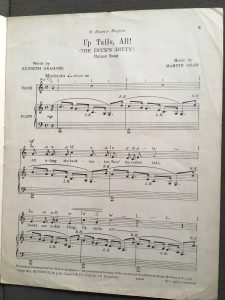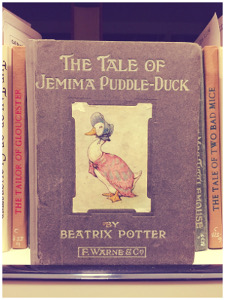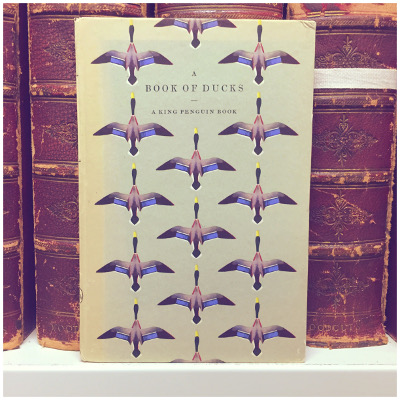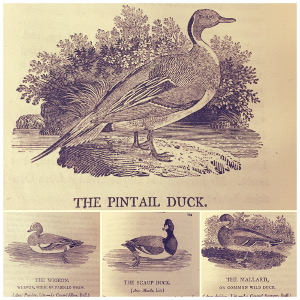Written by Bethan Davies, Trainee Liaison Librarian.
After a special visit from our friend Hodor from Reading University Library, we decided to take a deeper look at our duck related objects in our collection. Along the way, we found several literary pseudonyms, famous works set to music, and a very famous Beatrix Potter creation…

The title page of Book of Domestic Poultry (Reserve 636.5) with illustration of wild poultry.
The Illustrated Book of Domestic Poultry, ed. Martin Doyle
Published in 1854, The Illustrated Book of Domestic Poultry includes stunning oil colour prints of a range of domestic fowl, and includes detailed information on breeding and rearing individual species. The named editor “Martin Doyle” is actually the pseudonym for the Irish writer and philanthropist Rev. William Hickey. Hickey was concerned with the state of the poor Irish farmer and wrote several tracts relating practical advice on husbandry and agricultural methods.
The illustrations from this title were drawn from nature by Charles Havey Wighall (1794 – 1877), a landscape and portrait painter. Wighall also wrote several guides to painting and drawing, including the apt Guide to Animal Drawing (1862).
Ploof the Wild Duck, by Lida

Ploof the Wild Duck (Children’s Collection F. 598 LID.
Taken from our Children’s Collection, Ploof the Wild Duck (1938) follows the titular duckling as he grows up alongside his seven siblings, exploring the lake and hiding from predators along the way. The book is actually a translation of the French original (previously titled “Plouf, canard sauvage”). It is part of the Pere Castor’s Wild Animal Books series. Pere Castor (real name Paul Faucher), was an influential educator, who used his new publishing business to create a series of educational works for children. For Castor, images were particuarly important in ensuring children remembered the information they were being given. Thus Castor’s books stood out from other children’s books at the time for having high quality designs and illustrations. The illustrations in Ploof are drawn by the Russian illustrator Feodor Rojankovsky (Rojan), a respected children’s illustrator who worked with Castor on several works, before moving to America.

Up Tails, All! appears in the Cramer’s Library series, as part of the Finzi Music Reserve Collection 780.81 SHA 4.31
Up Tails, All! (The Duck’s Ditty), Martin Shaw & Kenneth Grahame
In the children’s classic The Wind in the Willows, Ratty, sitting by the river, makes up a “ditty” about his
friends the ducks. The poem was later put to words by the composer Martin Shaw, in “Up Tails, All! (The Duck’s Ditty)”. Shaw who helped to edit The Oxford Book of Carols, was noted for his commitment to the English church and “Englishness” in general. The song was especially popular with school children, with the children being told to “wag their fingers” along to the beat!

Our first edition copy of Jemima Puddle Duck (Children’s Collection 823.9.
The Tale of Jemima Puddle Duck, by Beatrix Potter
Possibly the most recognisable of the duck related works in our collection, (and this blog writer’s personal favourite), The Tale of Jemima Puddle Duck is one of the most popular of Beatrix Potter’s works. The tale follows a similar narrative to Little Red Riding Hood and other fairytales, as the naive protagonist is led into danger. The tale is also notable for showcasing Potter’s realistic portrayal of life and death on the farm. Our original first edition copy is part of our larger series of the Tales of Beatrix Potter.
If you want to follow Hodor in viewing these books, you can find them through our Library Catalogue, or contact us directly via phone or email!
References
Bromley, H. (2001). Tale of Jemima Puddle Duck, the (1908). In V. Watson (Ed.), The Cambridge guide to children’s books in English. [Online]. Cambridge: Cambridge University Press.
“Charles Harvey Weigall”, 2017. National Galleries Scotland. [Online] Available at: https://www.nationalgalleries.org/art-and-artists/artists/charles-harvey-weigall
Goodwin, G. ‘Hickey, William (1787–1875)’, rev. Anne Pimlott Baker, Oxford Dictionary of National Biography, Oxford University Press, 2004; online edn, Oct 2009 [http://www.oxforddnb.com/view/article/13209, accessed 18 Oct 2017]
Lallement-Renonciat, Annie. “Castor, Père.” In The Oxford Encyclopedia of Children’s Literature. : Oxford University Press, 2006.
“Music suitable for Schools.” (1928). The School Music Review : A Monthly Periodical Devoted to the Interest of Music in Schools, 37(436), 140-141.
Nières-Chevrel, I.(2006). Rojankovsky, Feodor. In The Oxford Encyclopedia of Children’s Literature. : Oxford University Press.
Studwell, W.E. & Jones, D. (1998) “Martin Shaw”, Music Reference Services Quarterly, 6:4, 67-69, DOI: 10.1300/J116v06n04_15







